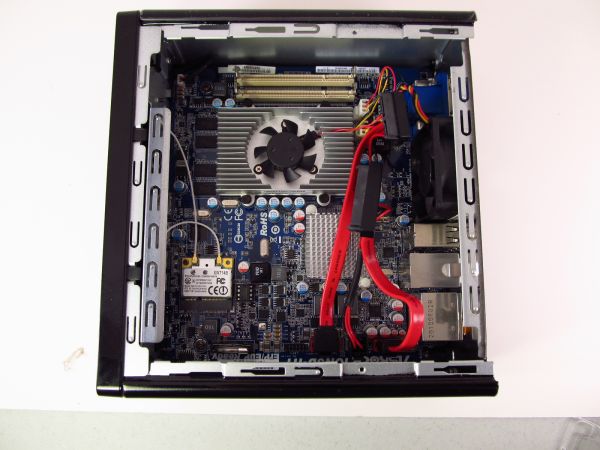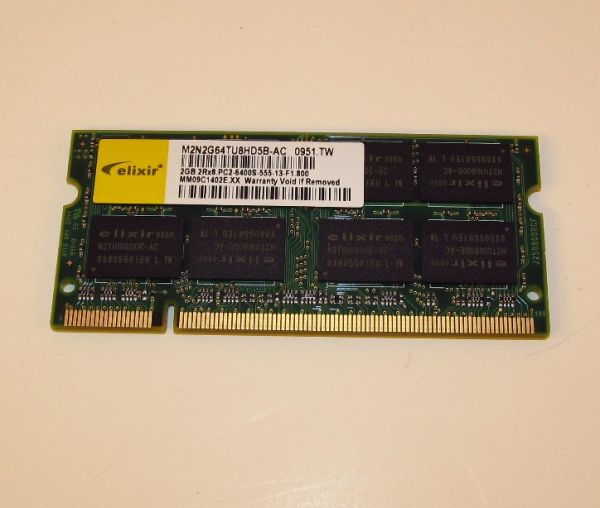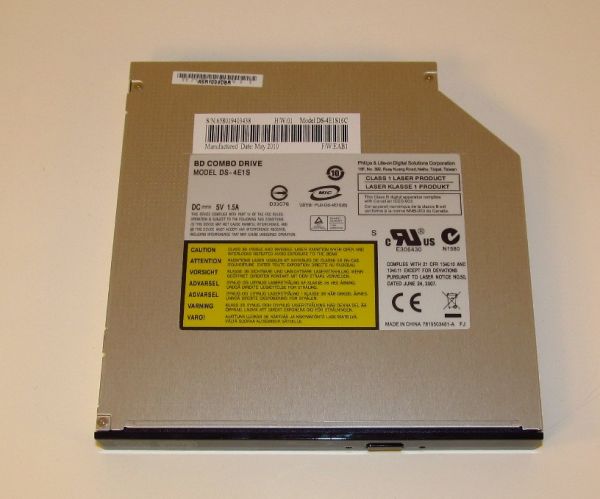ASRock ION 3D - A Next Generation ION HTPC
by Cameron Butterfield on January 14, 2011 3:30 AM EST- Posted in
- Home Theater
- ION
- ASRock
- Media Streamer
- HTPC
System Specifications, Teardown, and Analysis
The ION 3D lists the following as its system specifications:
- Intel Atom D525 dual-core processor
- Microsoft Windows 7 64-Bit
- Mobile Intel ICH8M Chipset
- 1x2GB DDR2 800MHz (expandable to 4GB)
- NVIDIA GT218 NG-ION Graphics
- 320GB 5400RPM HDD (SATA)
- BD-ROM/DVDRW combo drive
With the intent of this machine being a HTPC device, the ION 3D has a lot going for it. We have seen in previous reviews that NG-ION is a valid solution for watching high definition content. The GT218 GPU supports full hardware decode acceleration of all H.264 content; it should be able to play any video content at full 1080P resolution. While the CPU series utilized on this device is the low power Atom, the D525 is the fastest clocked dual-core Pineview iteration that intel has released to date.
The Processor: Intel Atom D525
The Atom D525 used in the ASRock ION 3D runs at a stock clock of 1.8 GHz and has two cores featuring Hyper-Threading, giving the device two physical cores and two logical cores. The CPU has an L2 cache of 512KB per core. ASROCK provides both software utilities and BIOS options that allow you to boost the CPU up to 2.1GHz quite easily. The D525 has a 13W TDP while the form factor of the device is the same as ASRock's models that utilize higher TDP CPUs, which means that ASRock doesn't have to use quite as much cooling on this Atom powered model as their other Mini-PC models
The GPU: NVIDIA NG-ION (GT218)
We've covered the technology used in the NG-ION previously. So far we have seen that the NG-ION is mildly better than the first generation iteration, with a few caveats. There are some limitations due to the PCIe x1 connection to the chipset; however this should not bottleneck HTPC tasks such as H.264 playback and video hardware acceleration, but rather limit the capabilities of gaming and GPGPU functions. The GPU has 512MB of DDR3, and this memory is not shared with the system, unlike integrated graphics solutions. For the intended function of this device the NVIDIA NG-ION will likely prove to be a good choice.
Memory: Elixir DDR2-800 MHz
The D525 processor is one of the models of Atom processor that supports DDR3 RAM, but ASRock choose to use DDR2 on this device. Only one of the slots was occupied in our sample, which means that it is expandable up to 4GB if another stick is added.
Hard Disk: Hitachi Travelstar 5K500.B
The included hard disk is a Hitachi 2.5" drive this time, slightly smaller than the seagate 500GB HDD used in the Core 100HT-BD, but the ION 3D's lower cost comes at the expense of performance and a few different component choices. This particular hitachi model is still a good choice for low power consumption and it's large enough for most users, especially those who will be streaming the majority of their media from a server. This drive can be found for roughly $51 online. It would be nice to see a low cost SSD option (i.e. something like the Intel 40GB drives); that wouldn't add too much of a price premium and would improve boot times and responsiveness compared to a conventional HDD—especially the 5400RPM drive used here.
Optical Disk Drive: Philips / Lite-On Blu-Ray / DVD RW
The ASRock ION 3D ships with the same Lite-On DS-4e1S that was found in the Core 100HT. You get Blu-ray playback functionality and DVD burning capabilities at a reasonable price.
Miscellaneous Components
The ION 3D uses a Realtek RTL8191SU 802.11b/g/n network adapter; this is only capable of connecting to 802.11n 2.4GHz networks and not 5GHz networks. The Vision 3D and Core 100HT seem to use wireless adapters with slightly more features, but this is likely another choice where ASRock has elected to keep costs down.













30 Comments
View All Comments
jabber - Friday, January 14, 2011 - link
Pretty much, just a refresh really.icrf - Friday, January 14, 2011 - link
It seems one of the most recommended boxes from the XBMC community is from the Acer Aspire Revo family. It sounds like $350 gets you something similar, the biggest loss is BD, but it is over $100 cheaper.http://www.newegg.com/Product/Product.aspx?Item=N8...
Any plans on one of these finding their way into your testing labs?
vol7ron - Friday, January 14, 2011 - link
It says it has Component A/V, but I don't see any; but I do see DVI.About the USB3 Comment:
They probably included it for marketing, even knowing it isn't full USB3. The more people you can mislead, the better your sales.
krumme - Friday, January 14, 2011 - link
"And indeed, the Brazos platform decimates Atom in single-threaded apps, still manages to beat it decisively in more parallelized programs, and embarrasses it in anything having to do with graphics"All for less money. How obvious can it be.
As stated before go to:
http://www.tomshardware.com/reviews/asrock-e350m1-...
What was this review about anyway?
silverblue - Friday, January 14, 2011 - link
Until Cedar Trail, Atom isn't a viable platform. I'm interested in seeing how Cedar Trail performs, though, especially if it performs as rumoured.pirspilane - Friday, January 14, 2011 - link
I have a Core 100HT, and it has proved problematic. When I turn off the TV, the HDMI audio stops and a reboot is required to bring it back. Playing a Sony PS3 through the same setup, I don't have this problem.I don't want to run my 600w plasma just to listen to iTunes. It defeats the purpose of having a low power HTPC.
The problem I suspect is with the HDCP handshake. While the PS3 recovers its sound after the TV is switched off, the ASRock's Intel chipset/drivers can't.
A workaround is using the Toslink output. But even then, the ASRock sometimes hangs when the TV is switched on again. Today, I had to power it down with the front panel button. But when I restarted it, the Bluetooth transceiver didn't come on and I had to get a USB keyboard to get the thing working again. So it took me about 15 minutes to get a youtube video to play.
thewhat - Saturday, January 15, 2011 - link
"USB 3.0 devices may not be needed by the target users of this device"Huh?
I was under the impression that you can copy files to/from this device. How is a fast transfer speed not needed?
I'm personally hesitant to get anything that stores data without USB 3 nowadays.
Spacecomber - Saturday, January 15, 2011 - link
I skimmed through this article, but I didn't really see what I was looking for, which is some idea of how well this would work for handling live streams of video of off the internet. Just playing around with different computer set ups that I have in the house, I've been surprised at how much processing power this kind of content seems to use. For example, I'd have thought that Pentium 4 @ 3.4 GHz or an Athlon XP at 2.3 GHz would do a better job. I'm getting the impression that a dual core is needed for these online flash video streams.Any thoughts on what the minimum amount of processing power is that would be needed for this kind of work (leaving aside GPU acceleration, since I find that rather iffy and perhaps best not counted on at this point)?
Jello1o - Sunday, January 16, 2011 - link
I have an older Atom dual-core (the 510) server running and while it is capable of playing back standard-def flash, there will be a bit of choppiness in the video. Without GPU acceleration I would not recommend any Atoms for flash playback at the moment. Even my Core 2 Duo(technically Pentium) E5200 desktop is usually at %60 with flash video and sometimes up to %80 with the high quality flash video.I'm using my Atom D510M0 based system as a web/email and DLNA server. It seems to be adequate for those uses.
schlos - Sunday, February 19, 2012 - link
hi,i just wanted to check and confirm that, you can still send TrueHD and other DTS variations via the SPDIF optical out, and an AV receiver can decode it instead, correct?